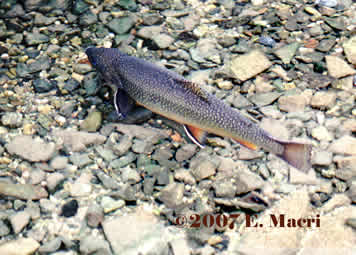
Brook Trout EcologybyEugene P. Macri Jr.You may use these articles. You can store them. You can read them. You may not change, republish, sell or redistribute these articles in anyway for any monetary gain. You may not add them to your collection and sell them etc. These articles are copyrighted and we will strictly enforce the copyright. © 2010 E. P. Macri Jr. The Brook Trout may be one of the most beautiful animals on earth. The Brook Trout goes by many different
names depending upon its location. Often called the "speckled Trout" by many anglers, and sometimes
"squaretail, or brookie by others. The Brook Trout is actually not a true trout but belongs to a closely
related group called the "Chars" which include Lake Trout and the Dolly Varden sometimes referred to as "Bull
Trout." The Brookie belongs to the same family as brown and rainbow trout, the salmon family (Salmonidae).
The classification breaks down as follows: Kingdom: Animalia (Limestone Spring Creek Brook Trout)
Range of Brook TroutThe original range of the Brook Trout is from Eastern Canada, Northeastern United States extending into parts of Minnesota and the Appalachian Mountains as far south as Georgia. The Brookie has been successfully introduced out west and in other parts of the world.
Identification of Brook TroutBrook Trout are fairly easily differentiated from brown or rainbow trout. Brook trout have worm-like markings (vermiculations) on the dorsal or back area. They are often contrasted against grey or green areas. Also they have red-spotted and whitish spots on a background of a darker color. Their lower fins tend to be edged in front with a white stripe. Behind this white strip is bright red or orange. Anatomical difference include the fact that teeth on the vomer of the upper jaw are found only to front while in rainbow and brown trout the teeth extend well down the shaft. Habitat of Brook TroutBrook Trout inhabit streams, creeks, lakes and ponds. Some brook trout actually live in larger waters in Labrador and other places. It is a bit of a misconception to think of them as only inhabiting tiny waters. Furthermore, in the Cumberland Valley of Pennsylvania extremely sophisticated native strains of Brook Trout inhabited the limestone spring creeks including the famed Big Spring Creek near Newville, Pennsylvania. Stream Biological Parameters of Brook TroutBrook Trout require cold oxygenated water and water temperatures under 70 f. Brook Trout have less tolerance for polluted streams than browns or rainbows. Certain strains of Brook Trout can tolerate more acidic waters (5.0 ph) than rainbows and browns. Brook trout are a short lived species but are reproductively mature at one year which gives them an advantage over browns and rainbows. Their life span has been measured up to 9 years old. They spawn in the autumn when temperatures and day lengths are decreasing. However, Brookies in limestone spring creeks may spawn at different times compared to their freestone and lake relatives. Brook Trout also spawn well in lakes especially if there is upwelling in the gravels. Brook Trout favor water with upwelling. Some Brookies go to the sea just like rainbows, browns, and salmon. These Brookies are known as "Salters." In the Great Lake some brookies go in and out of the streams and lakes often cruising the coastline. They are aptly named "Coasters." Brook Trout in streams often favor shallow areas with less cover than browns or rainbows. This is especially true in spring creeks. Many fly anglers and even some biologists have trouble understanding what defines Brook Trout habitat compared to Brown Trout or Rainbow Trout. Steam improvement which often adds cover can be counter productive to Brook Trout populations and will actually favor Brown Trout. |
Fly Fishing For Brook Trout > Brook Trout Ecology
|
©2010 E. Macri

